
TONY Design 12-15Ton/Hour Peanut Shell Pellet Production Line Specification
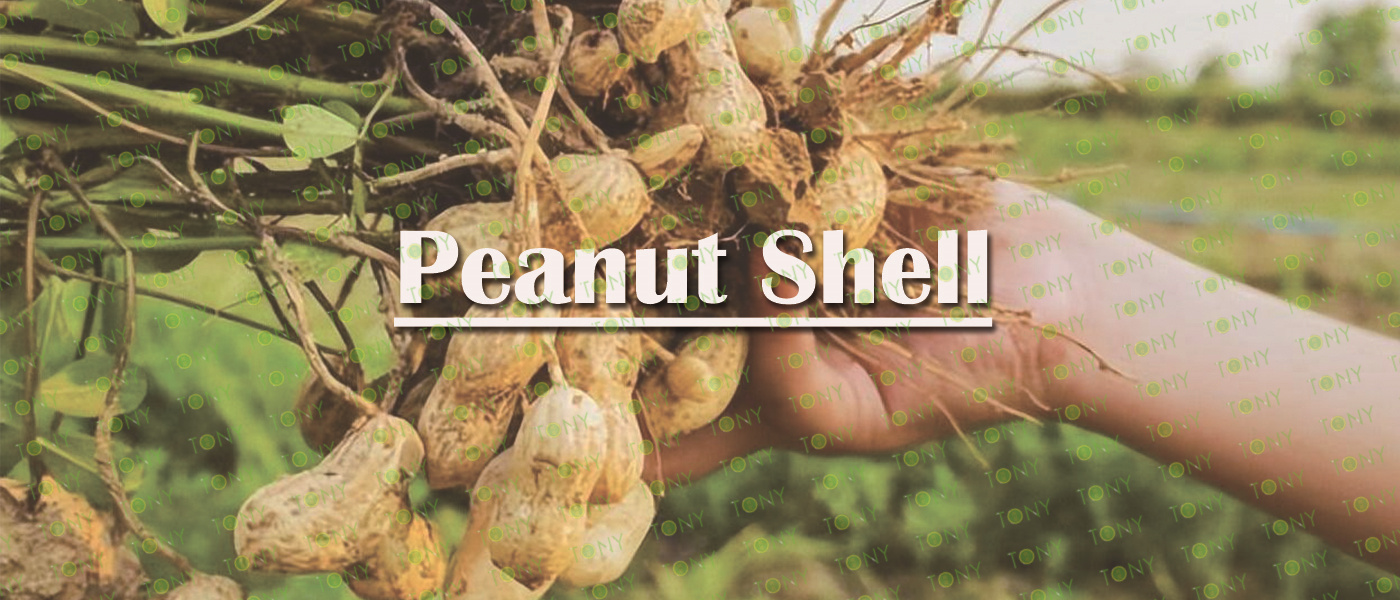
Global distribution of peanut shells
As a by-product, the global distribution of peanut shells is closely related to the areas where peanuts are grown. Peanut cultivation is mainly concentrated in Asia, Africa and the Americas, which account for more than 99% of the world's total peanut production. Here are some details about the global distribution of peanut shells:
1. Asia
Asia is one of the regions where peanut shells are most widely distributed. In particular, countries such as China, India, Indonesia and Myanmar have an important position in the production of peanuts in the world. For example, China's peanut production ranks second in the world, while India is the world's largest peanut producer41. Naturally, the production of peanut shells in these countries is also very considerable.
2. Africa
The distribution of peanut shells in Africa is mainly concentrated in West Africa, especially in countries such as Senegal, Sudan, Nigeria and Zaire. Peanut farming in these countries has a long history, and peanut shells are also used locally as a by-product.
3. America
Peanut shells in the Americas are mainly distributed in the United States, Brazil and other countries. The United States is the third largest peanut producer in the world, while Brazil is an important peanut producer in South America.41 Peanut shell production in these areas cannot be ignored.
4. Other Regions
Outside of the three continents mentioned above, peanut shells have relatively little distribution in the rest of the world. Peanuts are only sporadically grown in Europe and Oceania, so the production of peanut shells is relatively limited.
In summary, the global distribution of peanut shells is highly correlated with the area where peanuts are grown. Asia, Africa and the Americas are the most widely distributed areas of peanut shell, of which China and India in Asia, West African countries in Africa, and the United States and Brazil in the Americas are the largest areas of peanut shell production. Peanut shells from these regions not only have local applications, but also may flow to other countries and regions through international trade.
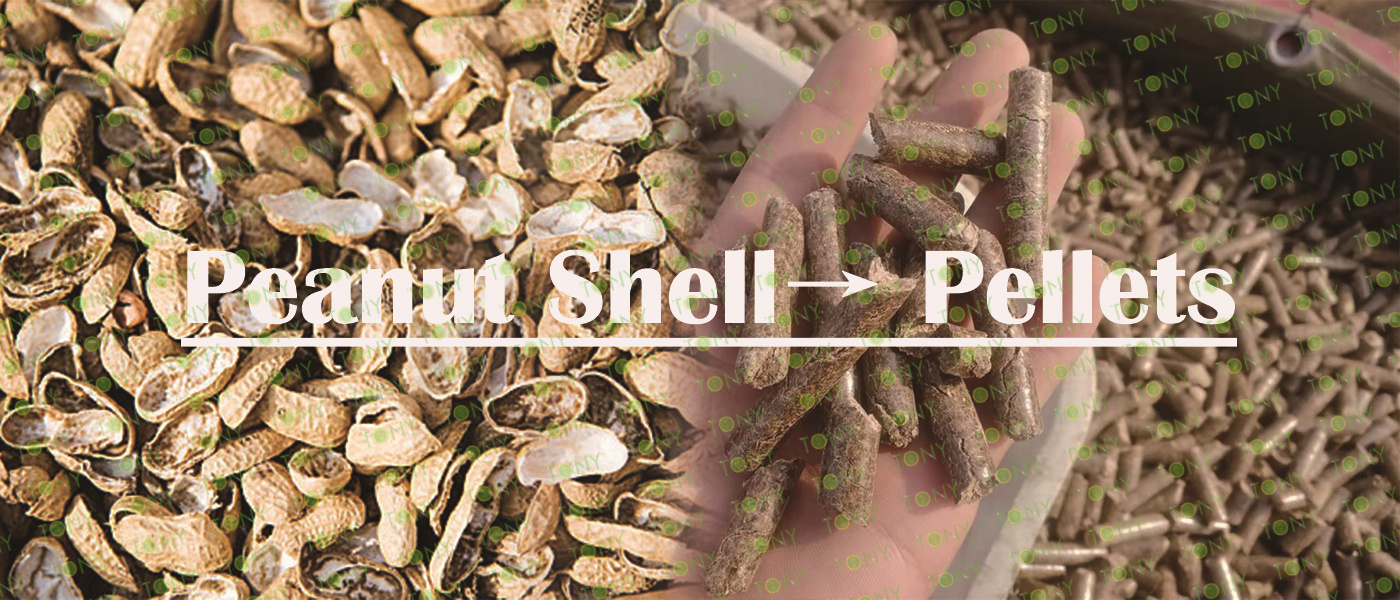

Peanut shells, a common agricultural waste, have long been overlooked. However, in recent years, with the enhancement of environmental awareness and the exploration of new energy sources, the potential of peanut shell as a biomass energy source has been gradually explored. Although the direct use of peanut shells as fuel has its limitations such as large volume, low combustion rate, and difficult transportation, its performance as a fuel can be greatly improved by proper treatment of it.
The granulation technology of peanut shell has brought new vitality to it. After granulation, the volume of peanut shells is significantly reduced, which not only improves the convenience of its storage, but also reduces the logistics cost. More importantly, the granulated peanut shell particles have many excellent combustion properties. They have the characteristics of high density, easy ignition, high combustion efficiency, and produce relatively little ash.
In addition, as a common agricultural waste, peanut shell has abundant resources and low cost of acquisition. This provides a strong guarantee for large-scale production of peanut shell pellet fuel, which brings considerable profit margins for producers. More importantly, peanut shell pellet fuel has lower emissions after combustion, less impact on the environment, and is a green and environmentally friendly biomass energy.
Based on the above advantages, peanut shell pellet fuel has a wide application prospect in the field of civil heating and daily energy supply. They can not only provide warmth for the home, but also meet daily cooking and hot water needs. In addition, in the industrial field, peanut shell particles can also be used as an ideal fuel for boiler power generation, providing a stable heat source for industrial production.
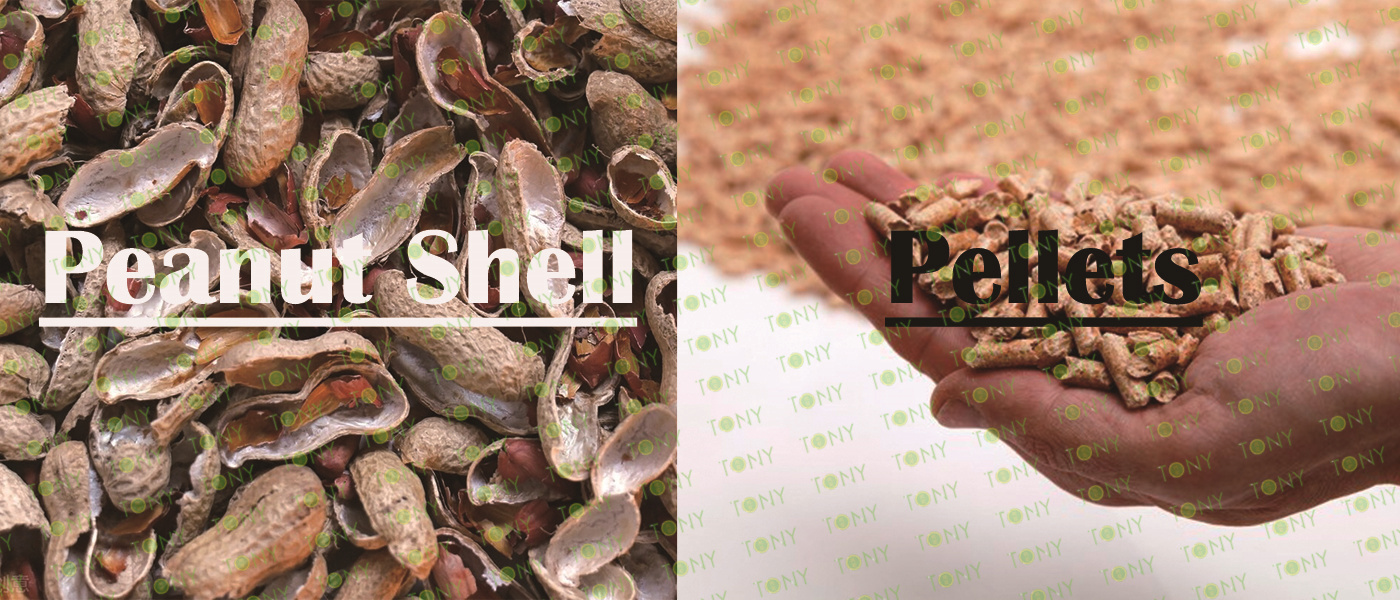
Peanut, formerly known as peanut (scientific name: Arachis hypogaea Linn.), is a kind of nut that is abundant in production and widely eaten, also known as "longevity fruit", "mud bean", "Muslin bean" and so on. It is an annual herbaceous plant in rosaceae, legumes, with erect or creeping stems, 30 ~ 80 cm long, wing flap separated from keel flap, pod length 2 ~ 5 cm, width 1 ~ 1.3 cm, dilated, thick pod, fruit period 6 ~ 8 months. It is mainly distributed in Brazil, China, Egypt and other places. There are various types of peanuts around the world, characterized by branching habits and branching length. Extensive peanut production has left an abundance of peanut waste, such as peanut shells and peanut fibers, which are now considered potential fuel sources.
The Value Of Peanut Shells
After harvesting and shucking, the peanut shell or shell is separated from the nut and accounts for about 20% of the weight of the dried peanut pod, which means a large amount of shell residual biomass left behind after processing. Peanut shells are used as cattle feed, poultry waste and garden mulch, and they are now seen as a potential source of fuel.
The Ingredients Of Peanut Shells
Although the composition of peanut shell varies with varieties, the main chemical composition of peanut shell does not change greatly with varieties. The main components of peanut shell are cellulose 37.0%, lignin 28.8%, protein 8.2% and carbohydrate 2.5%. The composition of peanut shells makes peanuts a disguised treasure, which can be used as fuel and feed production.
Peanut Shell Fuel Pellets
In order to make full use of the peanut shell and develop new energy sources, the peanut shell pellet machine can be used to press the peanut shell into fuel particles. Peanut shell granulator has two kinds of flat mold and ring mold. The former is commonly used for small-scale pellet production and is favored by home users, farmers, while the latter is used for large-scale pellet production and by medium and large pellet producers for large boilers and power generation.

1. Resource Utilization Perspective
(1) Rich Source Of Raw Materials
Peanuts are one of the most widely grown crops in the world. In the process of peanut processing, a large number of peanut shells will be produced, and these peanut shells will be made into particles, which can make full use of this rich agricultural waste resources to reduce resource waste.
(2) Renewable
Peanuts are an annual crop that is harvested every year, and the supply of peanut shells is constant. Compared with some non-renewable resources, peanut shell as a raw material for pellet production has the advantage of sustainable supply, in line with the concept of sustainable development.
2. Economic Value
(1) Lower Cost
The peanut shell itself is a by-product of peanut processing and is relatively inexpensive to obtain. Making it into particles can turn waste into treasure and reduce the cost of raw materials for particle production. In the pellet fuel market or other pellet applications, the lower cost can improve the competitiveness of the product.
(2) Create Economic Benefits
Peanut shell particles are widely used as fuel particles for heating, power generation, etc., because of its good combustion performance, it can replace traditional coal and other fuels to a certain extent, reduce the dependence on high-cost fossil fuels, and also bring economic benefits to related enterprises and producers.
3. Product Performance Advantage
(1) Good Combustion Performance
When peanut shell particles are used as fuel, they have a high calorific value, generally in the range of 3800-4200 kcal/kg. In the early stage of raw materials, proper drying, crushing and screening of uniform particles can improve the combustion efficiency; Moreover, when peanut shell particles burn, the flame is stable and the ash produced is relatively small. In addition, the ash is rich in nutrients such as potassium and can also be used as fertilizer.
(2) Suitable Physical Properties
Peanut shell biological granulation product has uniform size, good fluidity and packing density. This makes them more convenient during storage and transportation, and does not take up a lot of space loosely like peanut shell raw materials, which makes more efficient use of transportation space and reduces transportation costs.
4. Environmental Protection Value
(1) Reduce Pollution
Compared with the traditional direct combustion of biomass (such as the open burning of unprocessed peanut shells), the combustion of peanut shell particles is more adequate, reducing the harmful gases generated by incomplete combustion, such as carbon monoxide and polycyclic aromatic hydrocarbons. This helps improve air quality, especially in rural areas, and reduces environmental pollution from open burning of peanut shells.
(2) Carbon Emission Reduction Contribution
Peanut shell particles can replace fossil fuels to some extent. When peanut shell particles are used as an energy source, the net emissions of carbon dioxide are relatively low over their entire life cycle. Because the peanut shell absorbs carbon dioxide in the atmosphere during the growth process, the carbon dioxide released after the combustion of the particles can theoretically be absorbed by new peanut cultivation, thus playing a positive role in mitigating climate change.
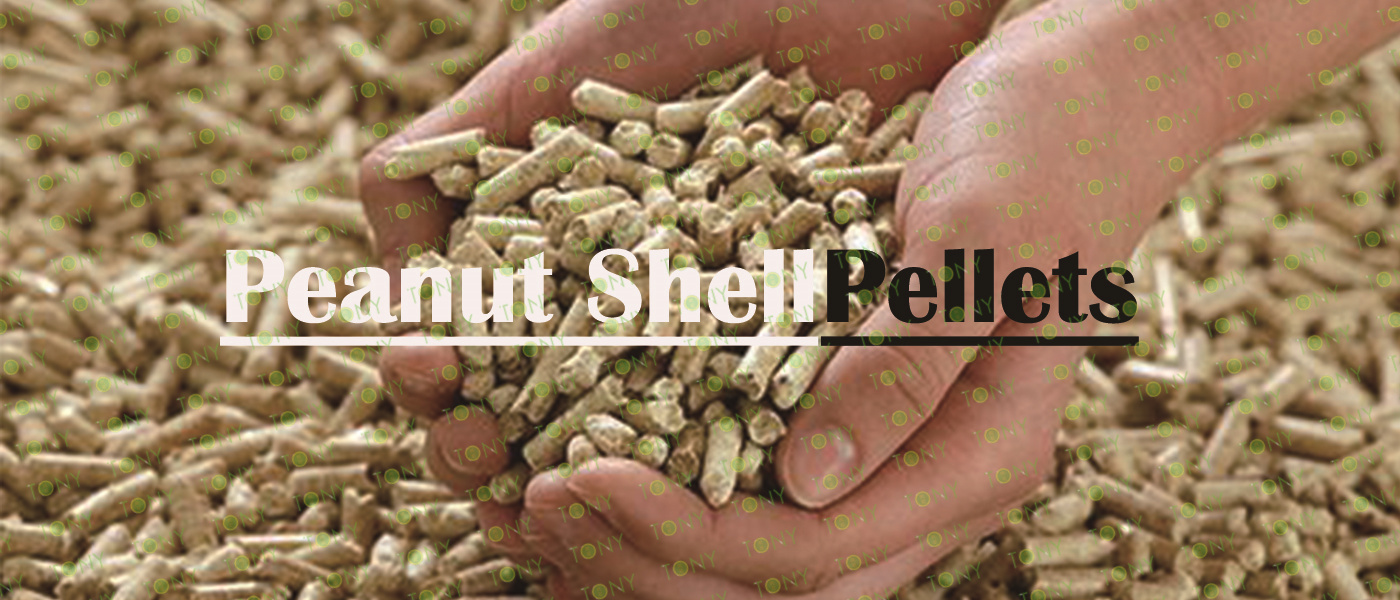

The advantages of peanut shell biomass pellets mainly include the following aspects:
Renewability:Peanut shell biomass pellet fuel is regenerative through the photosynthesis of plants, which belongs to renewable energy with rich resources and can ensure the recycling of energy.
Low Pollution: Peanut shell biomass pellet fuel has low sulfur and nitrogen content, less waste gas produced in the combustion process, and carbon dioxide emissions are close to zero, because plants absorb carbon dioxide in the growth process, thus reducing the greenhouse effect to a certain extent.
High Calorific Value:The calorific value of peanut shell biomass pellet fuel is higher, up to 3700 ~ 4000 kcal per kilogram, high combustion efficiency, the central temperature up to 1100℃.
Clean And Environmental Protection:The combustion dust discharge concentration is low, sulfur dioxide emission is 1/15 of coal, fuel oil 1/7, help to improve air quality, avoid greenhouse effect .
Convenient Transportation Easy Storage:Peanut shell biomass pellet fuel volume compression of nearly 9 times, easy transportation and storage, greatly reducing the cost of storage and transportation, and summer is not easy to mildew, fire retardant, suitable for long-term storage .
High Firepower Less Residual Ash: Peanut shell biomass pellet fuel in the combustion of the whole is not deformed, not scattered, easy to burn, less residual ash, collected residual ash can be directly returned to the field as potash fertilizer.
Wide Application Scenarios:Peanut shell biomass pellet fuel is suitable for all kinds of boilers and combustion equipment, especially in areas lacking coal can be used as the main energy.
In summary, peanut shell biomass pellet fuel has the advantages of renewability, low pollution, high calorific value, clean environmental protection, convenient transportation, easy storage and so on, and is an ideal clean energy.
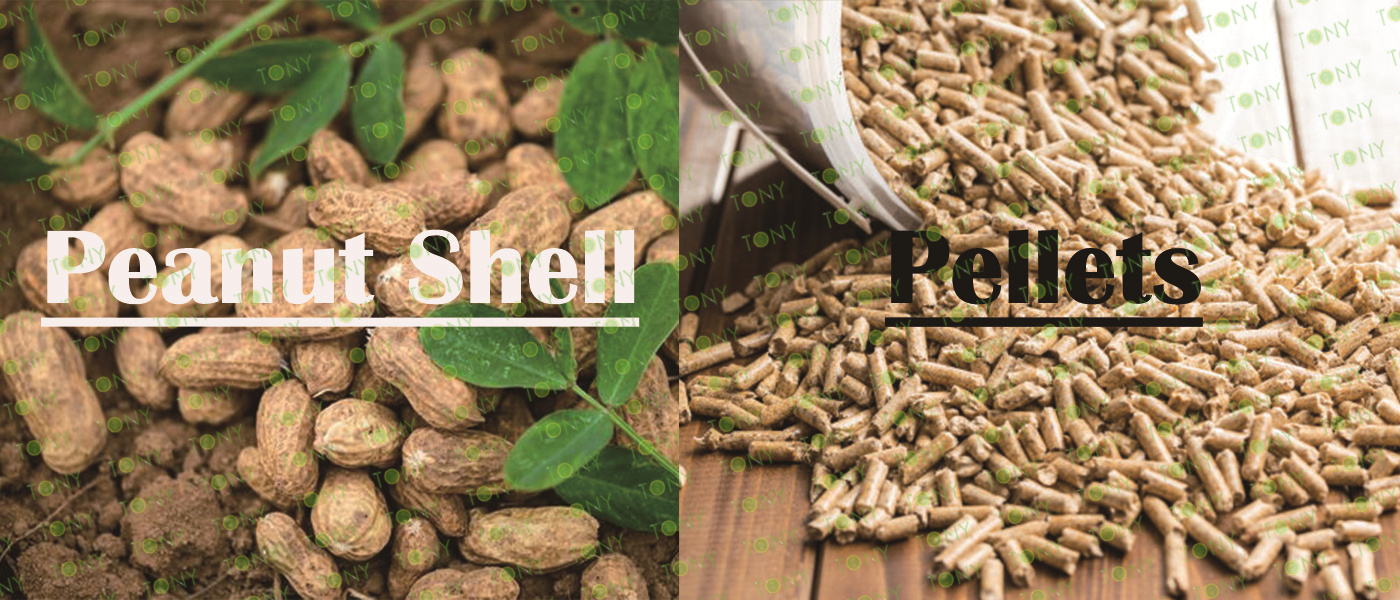

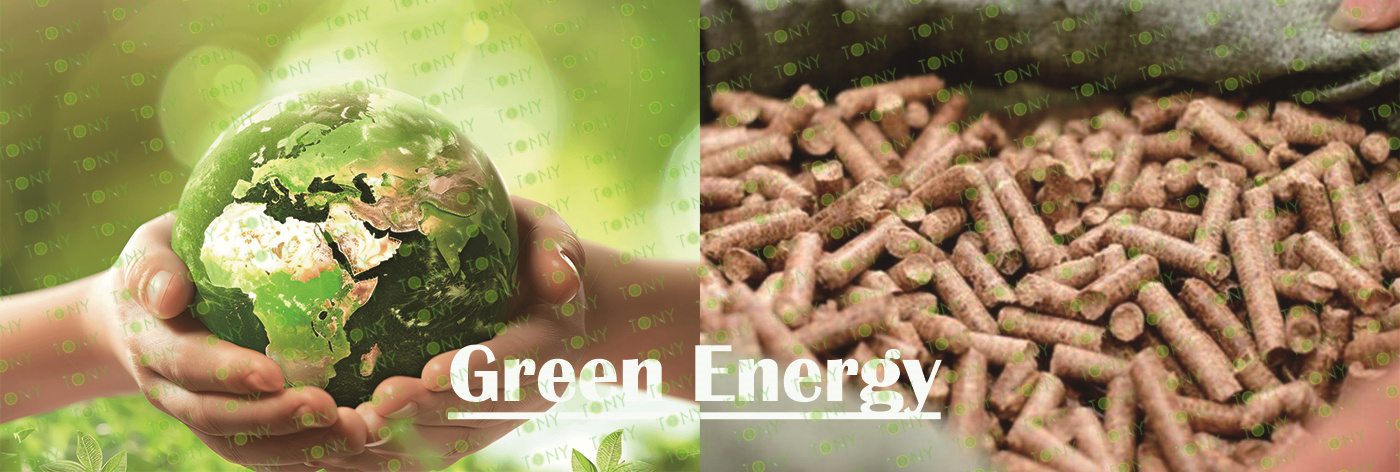
1. Overall Size Of Global Market
According to the global and China peanut shell pellet fuel market outlook in 2024, peanut shell pellet fuel has become a representative of clean fuel due to its high calorific value and low sulfur content. Compared with other biomass energy sources, its pollutant emissions are less, the impact on the environment is less, and it has the potential to occupy a certain market share.
2. Future Development Trend
The global peanut shell pellet fuel market is expected to continue to expand by 2030. The main growth drivers include the promotion of environmental policies and the increasing demand for biomass energy.
3. Application Field
Peanut shell pellet fuel is not only used for energy production, but also widely used in industrial and agricultural fields, such as replacing traditional fuels, producing biomass fertilizers and pesticides, which will further promote its market demand.
4. Industrial Chain Analysis
The industrial chain of the peanut shell pellet fuel industry covers upstream raw material supply, midstream production and processing and downstream product sales. Among them, the upstream raw material supply is mainly peanut shells, the midstream production and processing involve the production and manufacture of pellet fuel, and the downstream sales are for industrial and agricultural end users.
5. Policy Environment
Global government policy support for the biomass energy industry is helping to drive the peanut shell pellet fuel market. In the future, with the enhancement of environmental awareness and the further implementation of relevant policies, the market prospect of peanut shell pellet fuel will be broader.

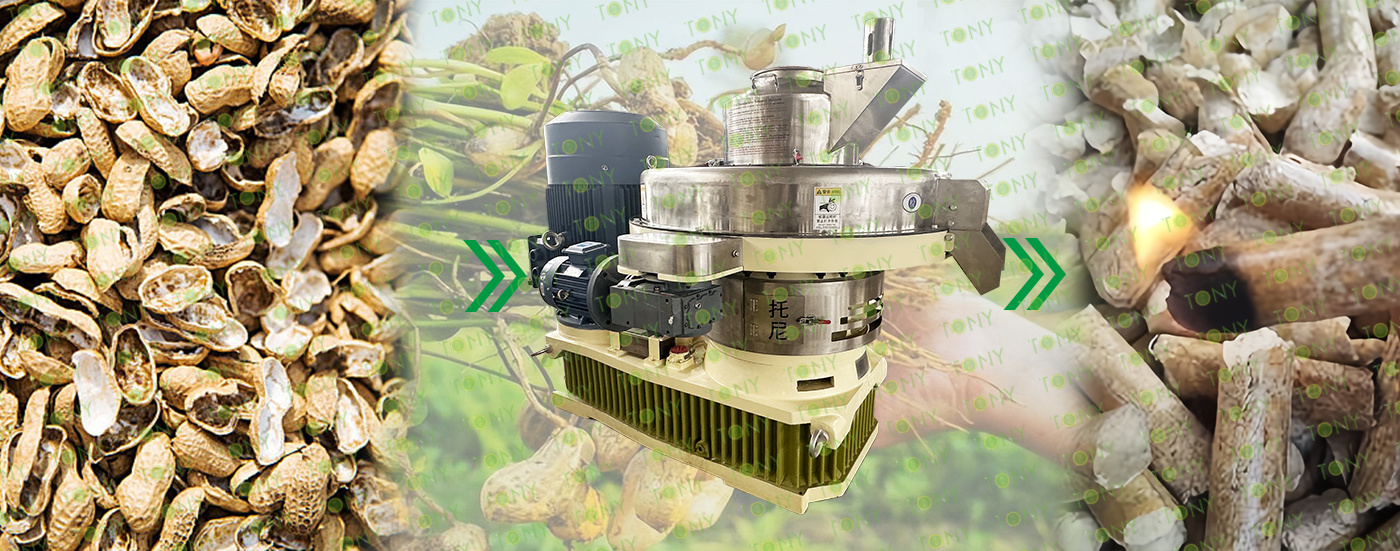
1.The Working Principle Of Peanut Shell biomass Pellet Processing Equipment
The process of making biomass particles from peanut shell is relatively simple, there is no need for crushing, crushing and other processes, and it can directly enter the granulation process and press into rod particles with uniform size and compact structure.The finished product has high particle density, can be burned, high calorific value, low ash content, and is often used as fuel instead of coal
2.Characteristics Of Peanut Shell Biomass Pellet Processing Equipment
(1)High Efficiency :TONY biomass pellet machine unique design, is high efficiency, large capacity output.
(2)High Quality Pellet Machine: The biomass pellet machine produced by Tony has solid work, stable operation and service life.
(3) The Equipment Has A High Degree Of Automation: Reduces manual operation, not only saves labor costs, but also can achieve efficient production.
(4) The Applicability Of Raw Materials Is Stronger: Many raw materials can be pressed biomass particles, only need to replace the mold and other accessories can truly achieve "one machine multi-purpose"
3.Application Scenarios Of Peanut Shell Biomass Pellet Processing Equipment
(1)Industrial Sector
In the industrial field, Peanut Shell particles can replace traditional fossil energy sources such as coal and fuel oil, and are used in industrial boilers, drying equipment, melting furnaces and other equipment. The combustion efficiency of biomass particles is high and the ash content is low, which can not only reduce the energy cost of enterprises, but also reduce the impact on the environment and achieve green production.
(2)Civil Field
In the civil field, biomass particles can be used for home heating, hot water supply and so on. Compared with traditional coal, gas and other energy sources, the combustion process of biomass particles produces fewer pollutants, which is conducive to improving indoor air quality. At the same time, the price of biomass pellets is relatively low, which also meets the actual needs of consumers.
(3)Biomass Power Generation
Biomass pellets can also be used for biomass power generation. By burning biomass particles, high-temperature and high-pressure steam can be produced to drive turbines and generate electricity. Biomass power generation has the advantages of renewable and environmental protection, and is one of the important development directions in the future energy field.
(4)Biomass Gas Field
Biomass particles can also be converted into biomass gas through gasification, cracking and other technologies, and used in gas-fired power generation, gas-fired boilers and other fields. Biomass gas has the advantages of high calorific value, clean and environmental protection, and is an important alternative to traditional fossil gas.

1.Project Name:Peanut Shell Pellet Line
2.Raw Materisl: Peanut Shell
3.Moisture Of Raw Material: Dry Type 10-15%
4.Capacity:12-15Ton/Hour
5.Proecss: Storage Process-Pelleting Process-Cooling Process
6.Main Machine:Storage Silo,TONY Pellet MachineTYJ551-Ⅲ-132kw.Pellets Cooler And BeltConveyors
Total Power: About 880KW
Need Area: About 600-700㎡
Project Country:China
Voltage:220V,50Hz

TONY Brand 12-15 tons/hour peanut shell pellet production plant can take peanut shell, various shells, such as rice husk, melon seed shell, hazelnut shell, walnut shell, etc., as raw materials, processing and curing into high-density pellet fuel, which is an ideal fuel to replace coal and oil, and has the role of energy saving and emission reduction. At present, it has been widely used in various countries of raw materials.
1.Capacity: 12-15 Ton/Hour
2.Raw Materials: Peanut Shell ,Sunflower Husk,Rice Husk, Hazelnut Husk,etc.
3.Moisture: Dry type ,about 10-15%.
4.Application: All kinds of Husk.
5.Suitable Customers: Green energy companies, large farms, private growers and other customers with advantages in raw materials.
6.Finished Pellets Markets: Large power plants (domestic customers, as well as Japan and South Korea, mainly South Korea more), domestic heating, industrial heating, combustion heat, heating heating, boiler room, school canteen, foundry heat source.


|
Project Brief Introduction: 1.Product: Peanut Shell Pellet Line. 2.Capacity:12-15T/Hour 3.TONY Brand 12-15Ton/Hour Peanut Shell Pellet Line Project Process 4:Main Machine: TONY Storage Silo,TONY Pellet MachineTYJ551-Ⅲ-132kw,Pellets Cooler And Belt Conveyors 5.Total Power: About 880KW 6.Need Area:About 600-700㎡ 7.Country: China |
Project Layout For Customer |
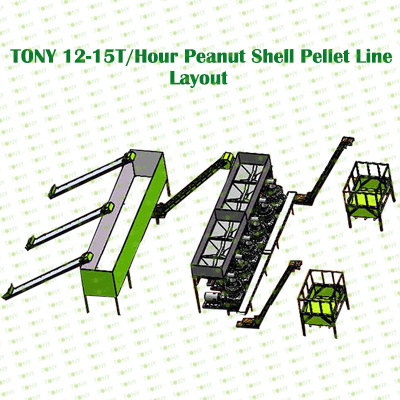 |


|
How to use TONY pellet line to proceed from.peanut shell into pellets? It mainly contains the following steps and machines as following: 1.To Use TONY Storage Bin To Storage Peanut Shell 2.To Use TONY Distribution Bin To Evenly Feed Granulator 3.To Use TONY Vertical Ring Die Pellet Machine To Products Pellets With φ6-8mm. 4.To Use TONY Pellets Cooler To Cool Pellets From 80-90℃ To 20-30℃. You Can Contact TONY To Get For More Details Information And Quoation. TONY Can Supply You All The Products As Above With Competitive Price And Excellent Quality. |
|
||||||||||||||||||||||||||||||||||||||||
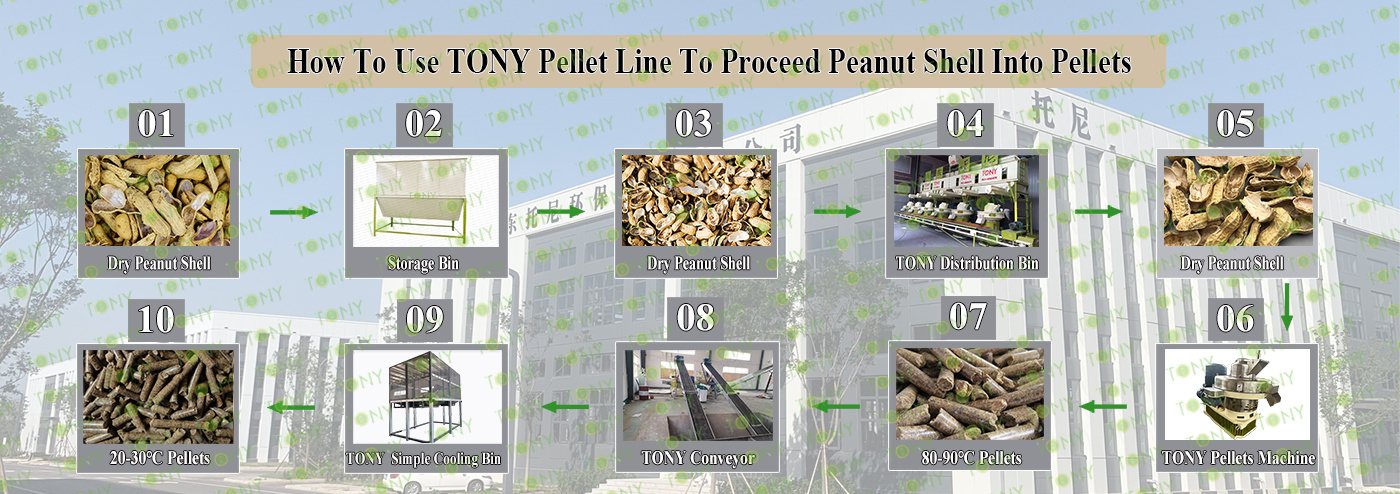


Following TONY Will Introduce For You For All The Necessary Machinery That Will Be Used For The Whole Pellet Production Line. Some machines can be custom made by customer according to different customer's detailed demand.Contact TONY for more details with quotation and layout.
 |
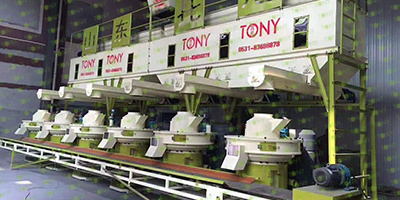 |
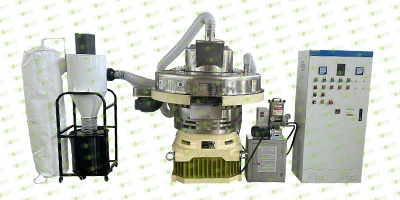 |
| Storage Bin | Distribution Bin | Vertical Ring Die Pellet Machine |
|
1.To Storage Plenty Of Peanut Shells 2.Model:TLC-40 3.Capacity:40m³ |
1.Distribute Large Amounts Of Peanut Shells Evenly Into The Pellets Machine 2.Model:TSLC-6 |
1.Model: TYJ551-Ⅲ-132kw*6 Sets 2.Capacity:2-2.5Ton/Hour/Set 3.New 304SS Type |
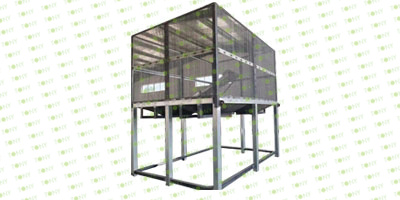 |
 |
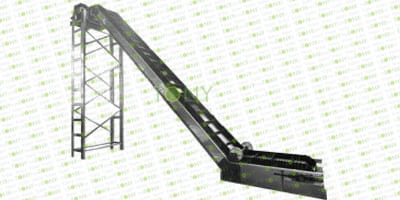 |
| Simple Cooling Bin | Belt Conveyor | Angle Belt Conveyor |
|
1.To Store Cooled Pellets To Prepare For The Packaging Process 2.Model:TJLN-80*2sets 3.Capacity:80m³/ set |
1.Transport Peanut Shell,Pellets. 2.Width: 60cm*7Sets 3.Capacity:Designed With The Whole Line |
1.Transport Peanut Shell,Pellets. 2.Capacity:Designed With The Whole Line |

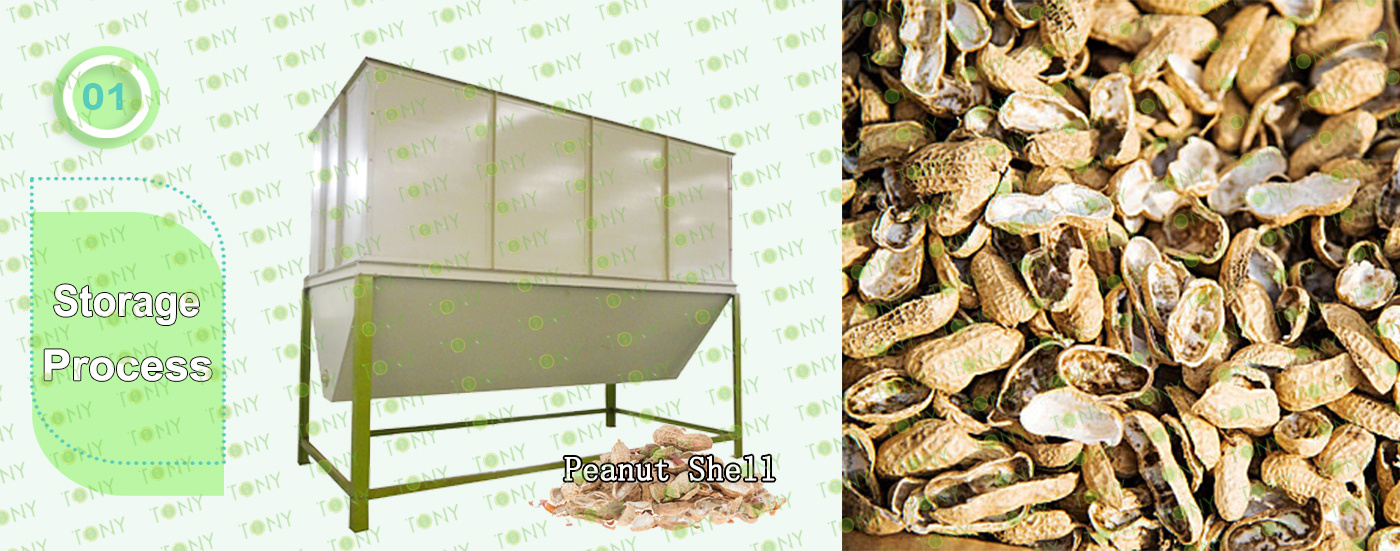
|
1.Storage Process A.This process is mainly used to storage peanut shell and venly distribute peanut shell. B.The customer chose 1 set of TONY storage bin and 1 set of TONY distribution bin. C.The peanut shell production line has a output of 12-15 tons/hour, and the customer chose a TONY brand silo to store peanut shells from. This process can be selected by the customer. If the customer does not choose a storage bin, the peanut shells can be stored directly on the ground, which may require some manual labor. In addition, it is equipped with a separate bin to realize the automatic uniform feeding of peanut shells to the pellet machine. Main Parts: (1)TONY's New Storage Bin&Distribution Bin. (2)With Screws Inside The Storage Bin To Prevent Wood Chips Blocked. |
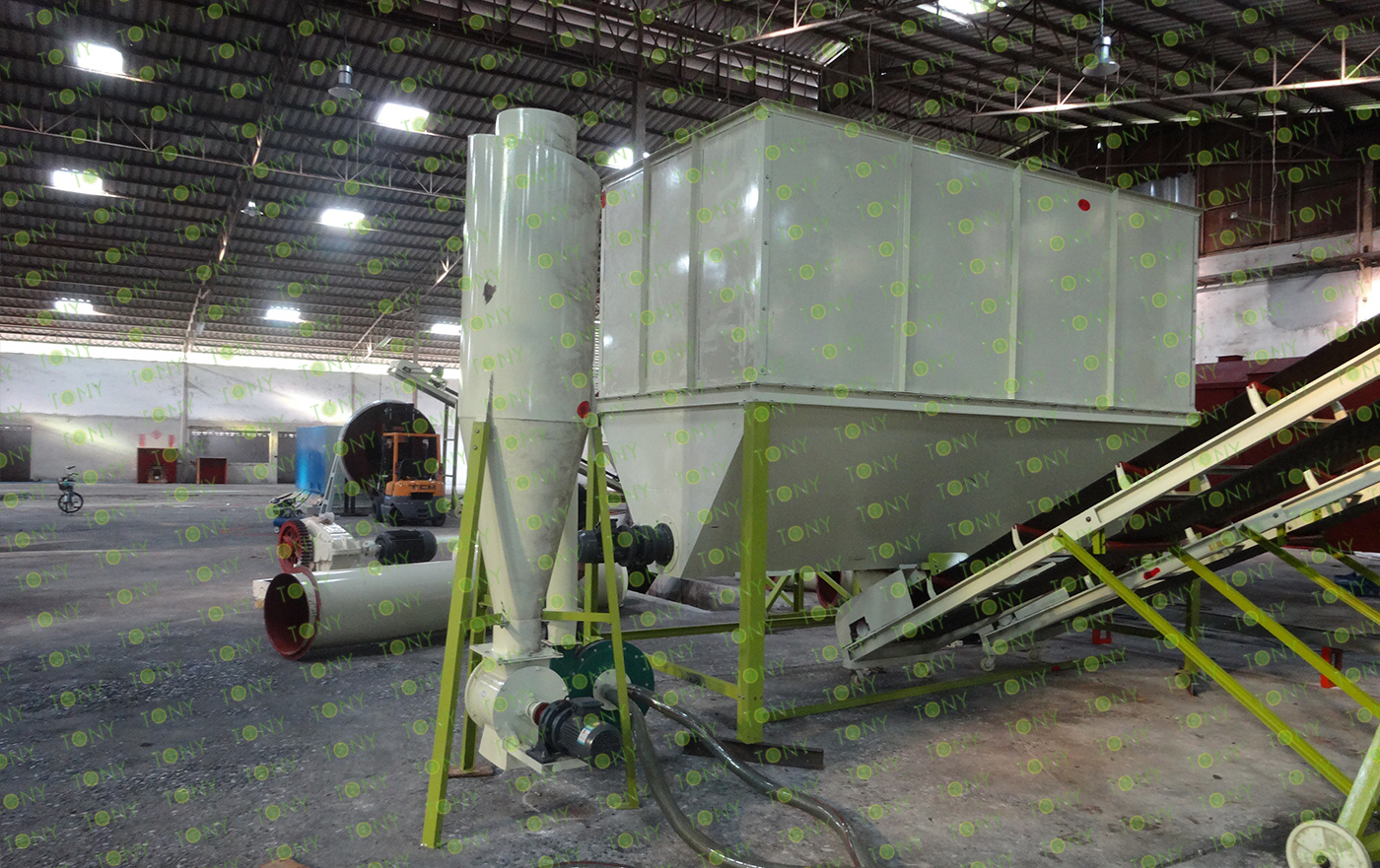

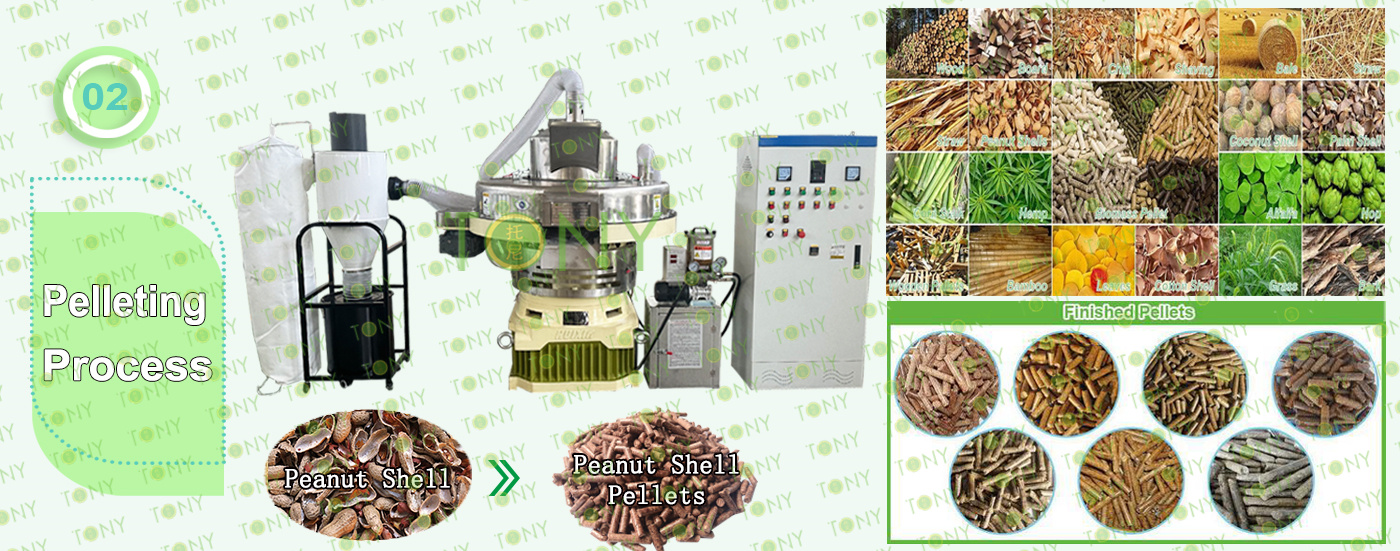
|
2.Pelleting Process: A.This process is mainly used to product pellets with φ6-8mm. Biggest Capacity:2-2.5 Ton/Hour/Set. C.The Customer Chose 6 Sets OfTONY Brand Vertical Ring Die Pellet Machine TYJ551-Ⅲ-132kw Total Capacity12-15 Ton/Hour. Main Parts: (1).TONY's new vertical ring die pellet machine. (2)Cyclone and bags dust collectors. (3)Bearings automatic lubrication system. (4)Electrical cabinets. You can choose TONY new type SS304 pellet machine or old type MS pellet machine. |
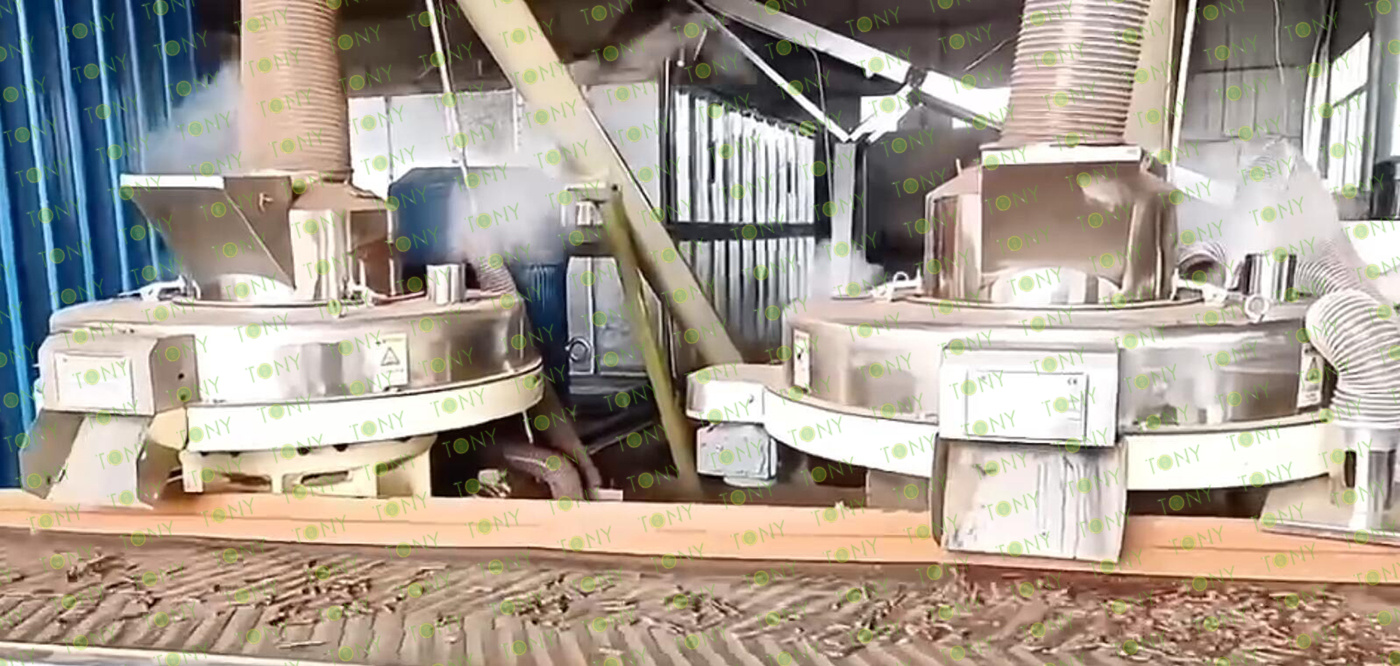

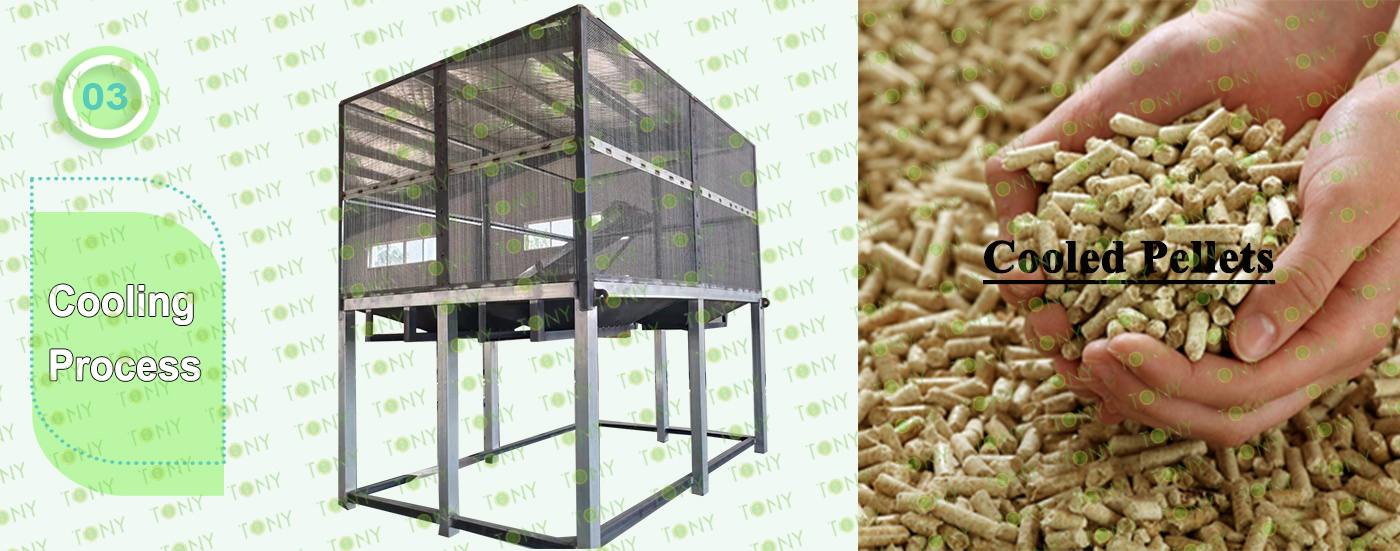
|
3.Cooling Process: A.This process is mainly used to cool pellets from 80-90℃ to 20-30℃ and store particles. B.The customer chose 2 sets of TONY simple Cooling Bin with capacity 80 m³/set Main Parts: (1)TONY's new Cooling Bin. (2)Customers can also choose to make their own. |
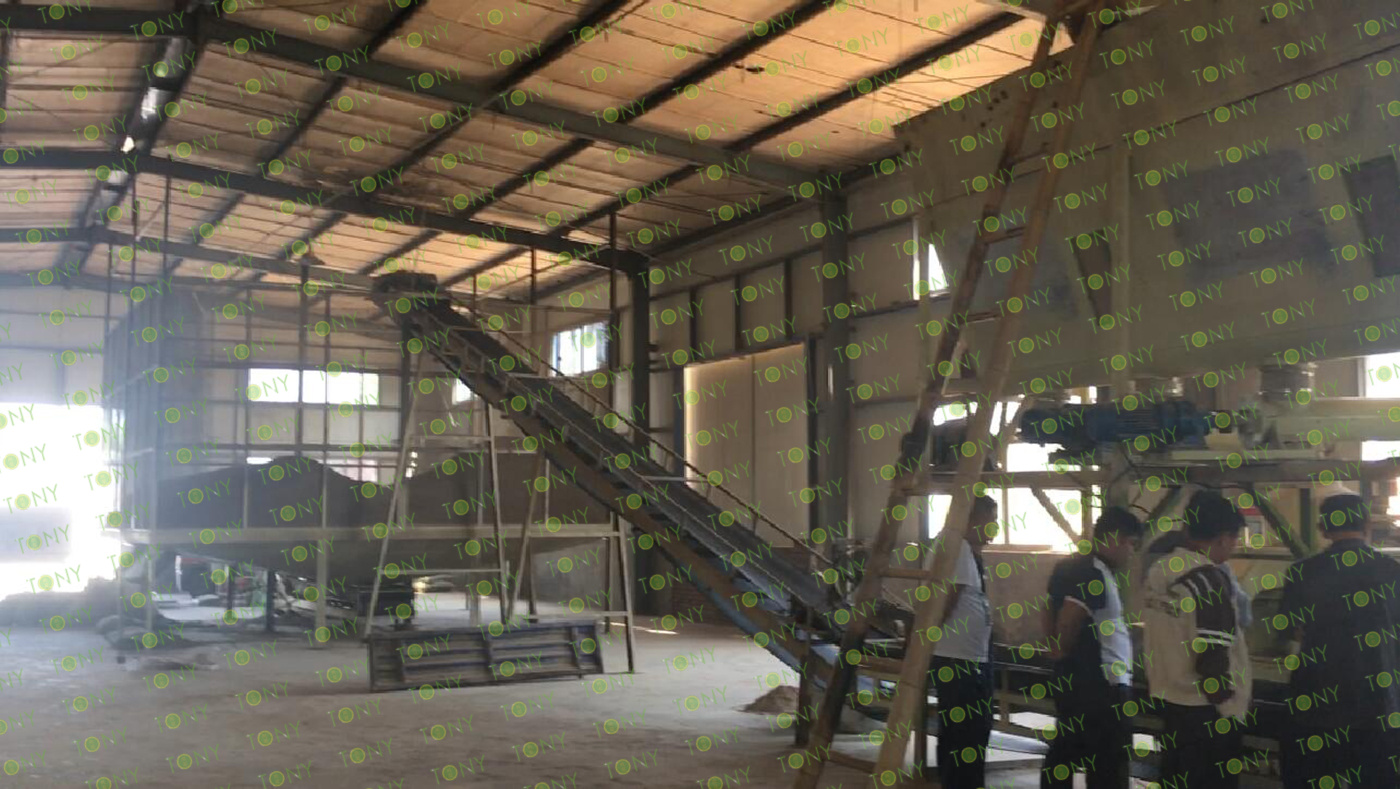

TONY Detailed Design 3D Layout With Detailed Size For 12-15Ton/Hour Peanut Shell Pellet Line According To Cusomer Factor Size
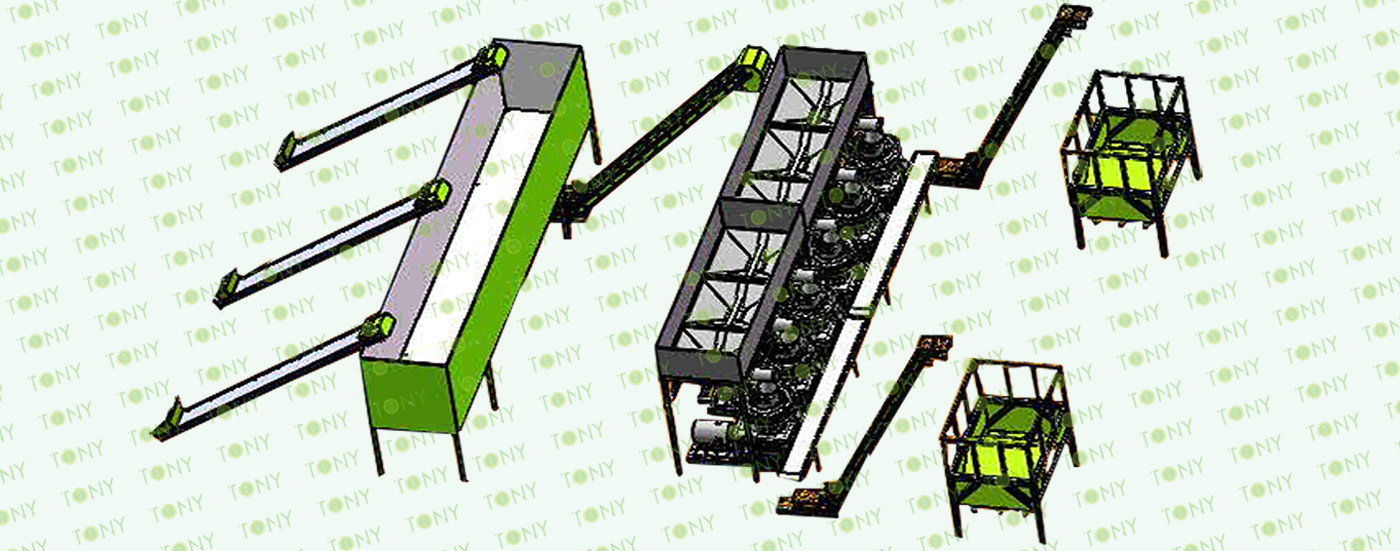

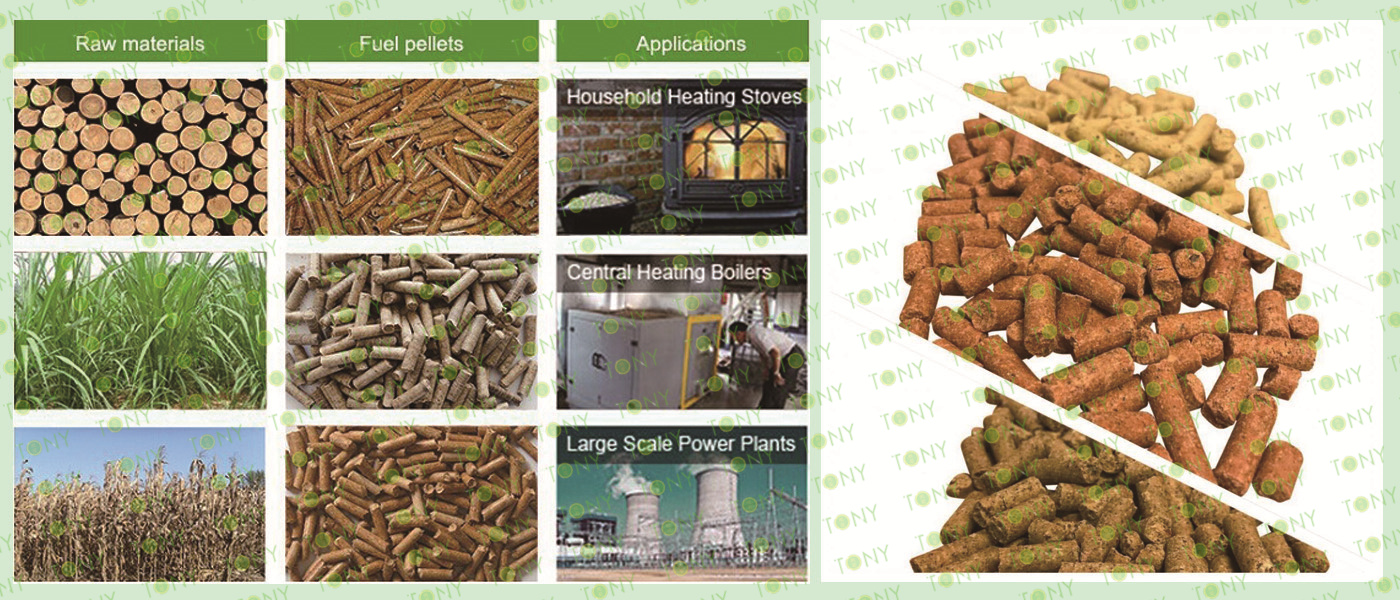
Product performance advantages of peanut shell particles
1. Good Combustion Performance
When peanut shell particles are used as fuel, they have a high calorific value, generally in the range of 3800-4200 kcal/kg. In the early stage of raw materials, proper drying, crushing and screening of uniform particles can improve the combustion efficiency; Moreover, when peanut shell particles burn, the flame is stable and the ash produced is relatively small. In addition, the ash is rich in nutrients such as potassium and can also be used as fertilizer.
2. Suitable Physical Properties
Peanut shell biological granulation product has uniform size, good fluidity and packing density. This makes them more convenient during storage and transportation, and does not take up a lot of space loosely like peanut shell raw materials, which makes more efficient use of transportation space and reduces transportation costs.
Application field of peanut shell particles
1. Industrial Sector
In the industrial field, rice husk particles can replace traditional fossil energy sources such as coal and fuel oil, and are used in industrial boilers, drying equipment, melting furnaces and other equipment. The combustion efficiency of biomass particles is high and the ash content is low, which can not only reduce the energy cost of enterprises, but also reduce the impact on the environment and achieve green production.
2. Civil Feld
In the civil field, biomass particles can be used for home heating, hot water supply and so on. Compared with traditional coal, gas and other energy sources, the combustion process of biomass particles produces fewer pollutants, which is conducive to improving indoor air quality. At the same time, the price of biomass pellets is relatively low, which also meets the actual needs of consumers.
3. Biomass Power Generation
Biomass pellets can also be used for biomass power generation. By burning biomass particles, high-temperature and high-pressure steam can be produced to drive turbines and generate electricity. Biomass power generation has the advantages of renewable and environmental protection, and is one of the important development directions in the future energy field.
4. Biomass Gas Field
Biomass particles can also be converted into biomass gas through gasification, cracking and other technologies, and used in gas-fired power generation, gas-fired boilers and other fields. Biomass gas has the advantages of high calorific value, clean and environmental protection, and is an important alternative to traditional fossil gas.

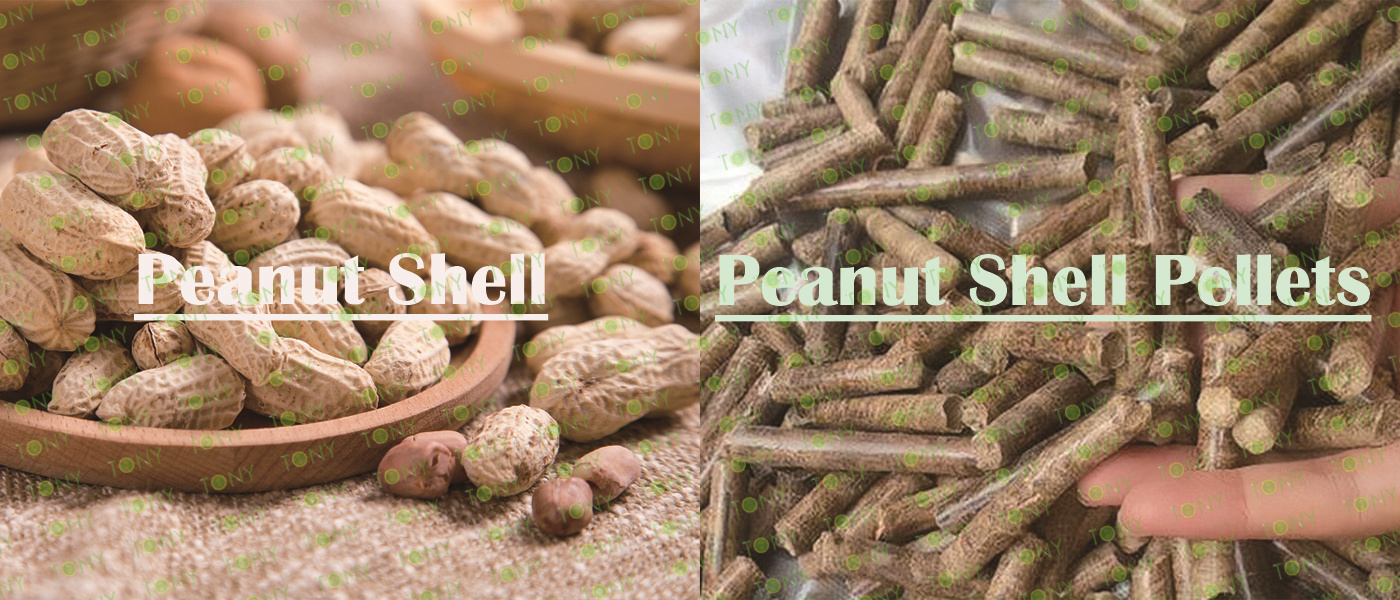
1. There Is A Growing Demand For Clean Energy
Large Demand For Alternative Traditional Energy: The use of traditional fossil energy such as coal has brought serious environmental pollution and greenhouse gas emissions, and the demand for clean energy is growing worldwide. As a renewable biomass energy source, peanut shell particles produce relatively few pollutants when burned. To a certain extent, it can replace coal for heating, power generation and other fields. For example, in some small biomass power stations as well as in domestic heating in rural areas. Peanut shell pellet fuel is already being used. With the continuous strengthening of environmental protection policies, this substitution trend will be more obvious.
High Stability Of Energy Supply: Peanuts are widely cultivated crops that produce large amounts of peanut shells each year, which provides a stable supply of raw materials for the production of peanut shell pellet fuel. Compared with some other renewable energy sources (such as solar energy, wind energy, etc.), the supply of peanut shell pellet fuel is not affected by natural factors such as weather, which can ensure a stable supply of energy.
2. Biomass Recycling Is Compatible With Agricultural Development
Driven By The Demand For Soil Improvement: The ash after the combustion of peanut shell particles is rich in nutrients such as potassium, which can be returned to the field as a high-quality organic fertilizer, helping to improve soil structure, improve soil fertility, and reduce the use of chemical fertilizers. In the context of the current focus on ecological agriculture and sustainable agricultural development, this natural organic fertilizer has a great market demand.
Biomass Recycling Is In Line With The Concept Of Agricultural Development: agricultural production will produce a lot of waste, peanut shell is one of them. The peanut shell is made into pellets, which realizes the reuse of waste and conforms to the development concept of agricultural circular economy. This model can not only reduce the pollution of waste to the environment, but also increase additional income for farmers, so it has broad development prospects in the agricultural field.
3. The Demand For Industrial Fuels Is Increasing
Industrial Boiler Fuel Demand Growth: Many industrial production processes require a lot of heat energy, and industrial boilers are important equipment to provide heat energy. Peanut shell particles can be used as fuel for industrial boilers, providing heat energy for food processing, paper making, textiles and other industries. As these industries continue to develop, the demand for peanut shell pellets as an industrial fuel will gradually increase.
The Choice Of Enterprises To Reduce Costs: Compared with traditional fossil fuels, the cost of peanut shell particles is relatively low, for some enterprises with large energy consumption, the use of peanut shell particles as fuel can reduce production costs and improve the economic efficiency of enterprises. Therefore, in the case of increasingly fierce market competition, the application of peanut shell particles in the industrial field will receive more attention from enterprises.
4. Large Demand In International Trade Market
Large Export Potential: Some countries and regions have a large demand for biomass energy, but their own biomass resources are relatively scarce. For countries rich in peanut shell resources, the production of peanut shell particles has cost advantages. It has certain export potential in the international market and is expected to become one of the important products of biomass energy export in the future.
Increasing Opportunities For International Cooperation: In the context of the global response to climate change, countries are actively promoting the development of renewable energy. As a renewable energy product, peanut shell particles provide a new opportunity for international energy cooperation. The state's enterprises carry out technical cooperation, investment and construction activities to jointly promote the development of the peanut shell pellet industry. The market prospect of using peanut shells as pellets is relatively broad

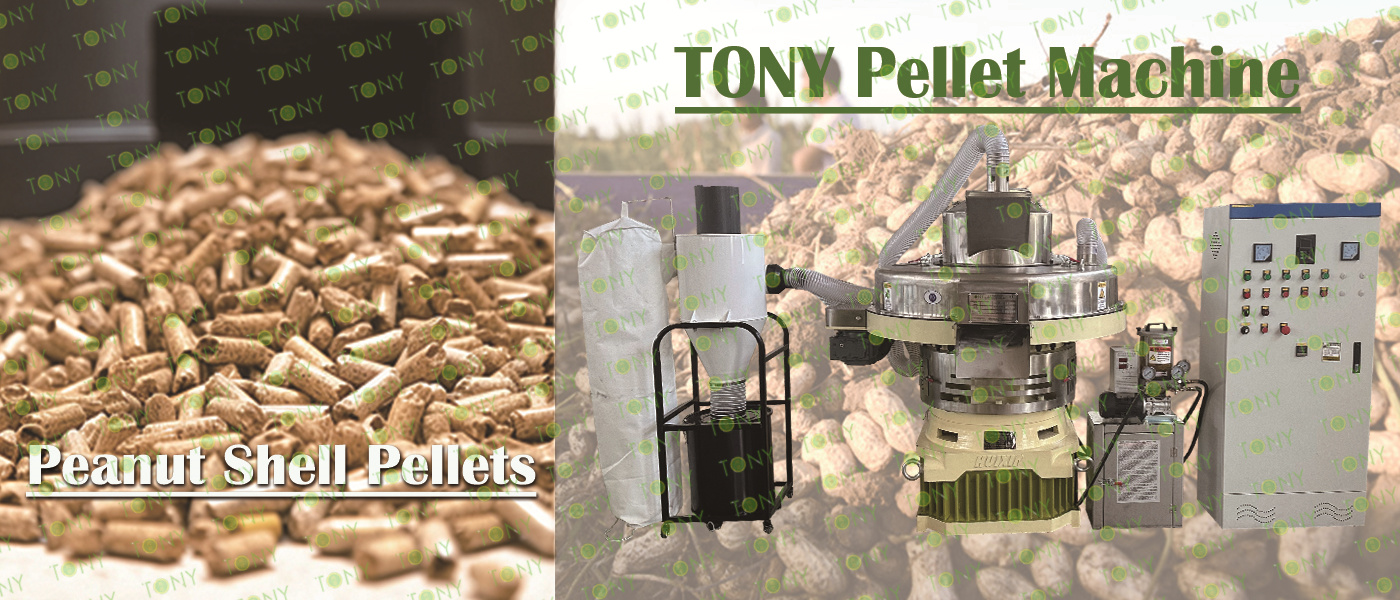
Peanut shell biomass pellet venture project is a business choice with broad market prospects. As a by-product of peanut processing, peanut shells are usually regarded as waste, but in fact, through scientific treatment and processing, they are made into biomass pellet fuel, which can be turned into valuable products.
1. Abundant Source Of Raw Materials.
The raw material sources of peanut shells are extremely wide and can be found in almost every peanut growing region. Both large peanut processing plants and small farmers produce large amounts of peanut shells every day.
These waste, which was originally regarded as a burden, has become "cake" in the eyes of recyclers. By establishing a stable recycling network, we can ensure an adequate supply of raw materials and provide a strong guarantee for production.
2. Broad Market Demand.
With the increasing awareness of environmental protection and the need for sustainable agricultural development, the demand for environmentally friendly products such as biomass fuels is growing. The products made of peanut shells after processing just meet this market demand. As an alternative energy source, biomass fuel has been warmly welcomed by the market.
3. Lucrative Returns.
The cost of recycling peanut shells is low, and after processing, it is made into biomass pellets, and the price is rising all the way. The profit margins are clear. If large-scale production can be achieved, the profit margin is even greater.
Moreover, with the continuous progress of technology and the continuous development of the market, this profit level is expected to be further improved.
Peanut shell pellet production line is not only a profitable entrepreneurial project, but also a public welfare enterprise with environmental protection and social value.
By recycling and reusing agricultural waste such as peanut shells, the exploitation and consumption of natural resources can be reduced, reducing the risk of environmental pollution and ecological damage. At the same time, it can also provide an additional source of income for local farmers and promote the development and prosperity of the rural economy. In addition, recycling peanut shells can also promote the formation and promotion of the development model of agricultural circular economy, contributing to the realization of sustainable development goals.
Peanut shell particle production line this unpopular business although it seems insignificant, but it contains huge business opportunities and potential.
As long as we can seize opportunities, innovate and work hard, we will be able to succeed in this field and realize our entrepreneurial dreams and life values.

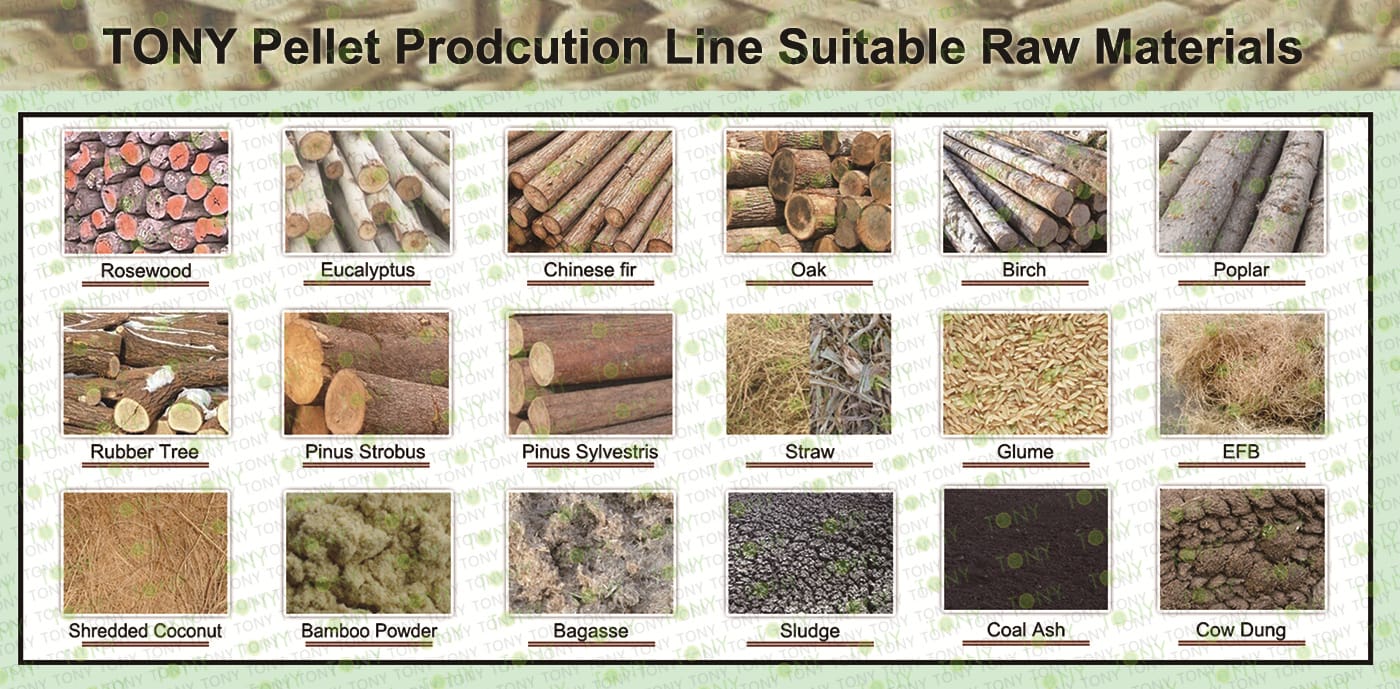
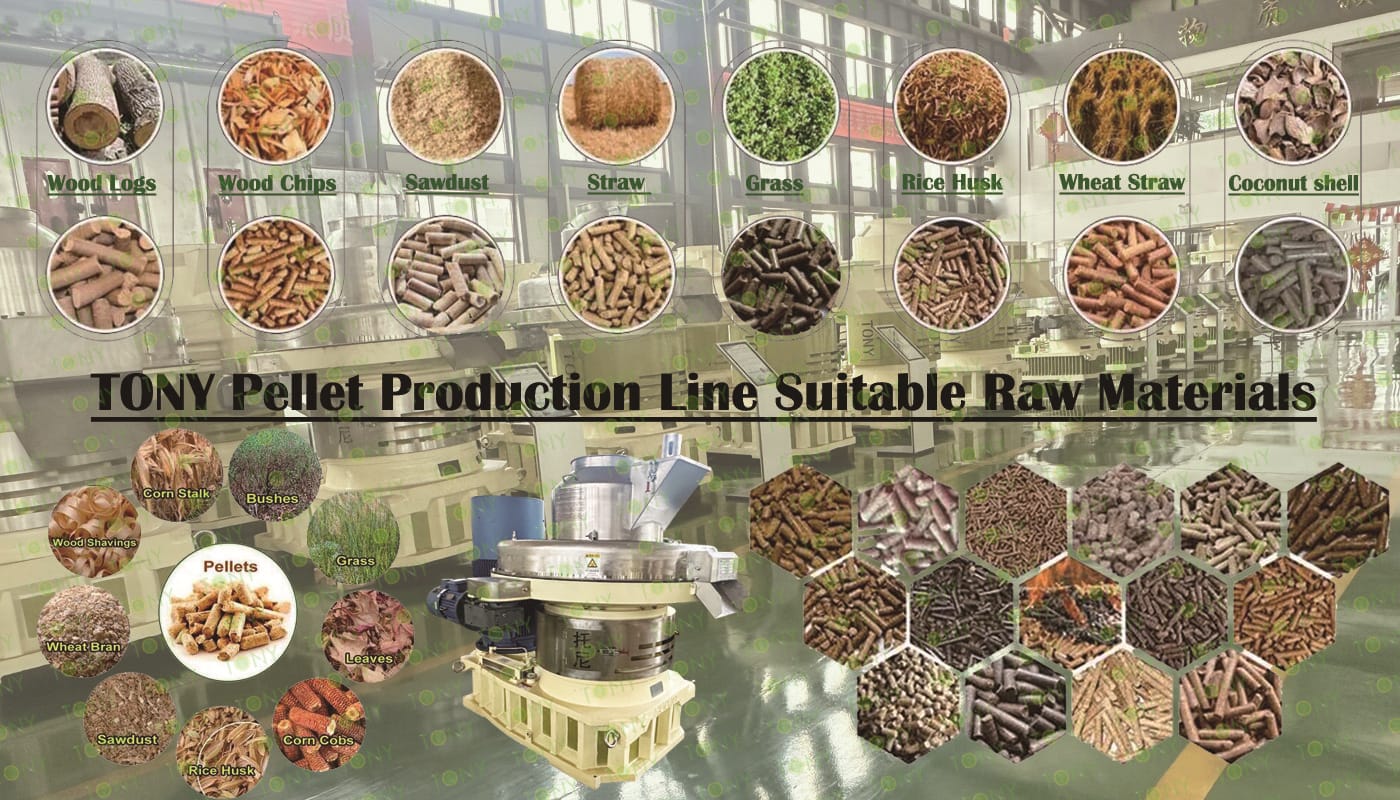



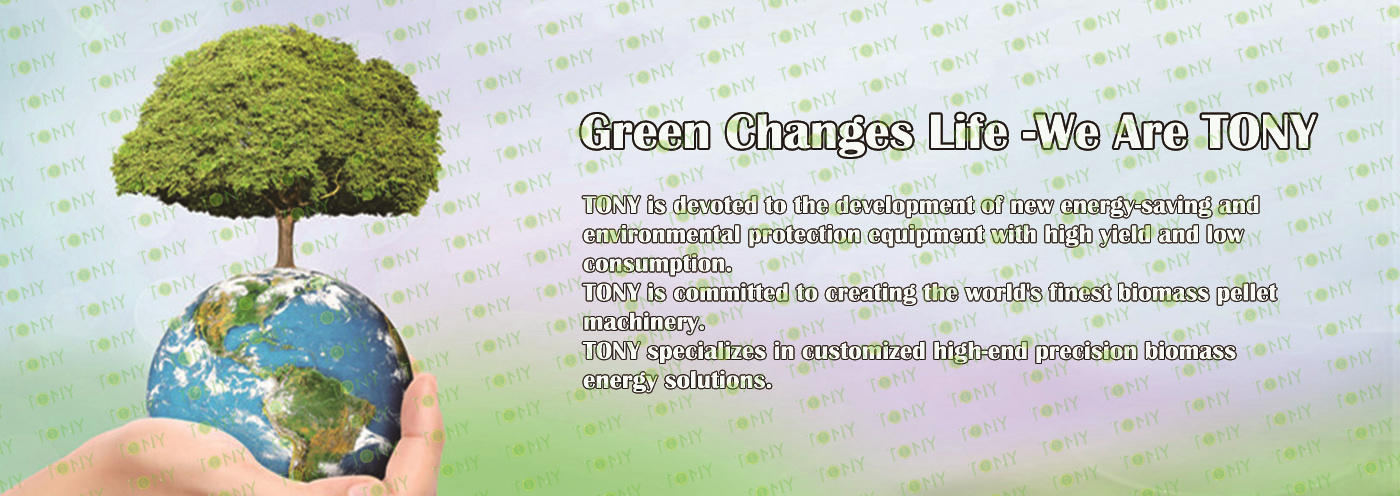
2025 Tony Machinery - All Rights Reserved. Map